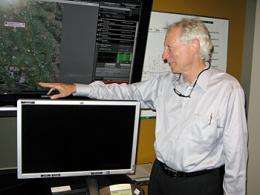To catch a speeding bullet

In 1992, East Palo Alto, a city of 24,000 on the San Francisco Peninsula, logged the highest homicide rate in the nation per capita. Gun violence and celebratory gunfire plagued citizens and police.
Pop. Pop Pop. Those sounds worried Robert Showen (B.S.’65 EECS), who worked at SRI International in Menlo Park, just two miles from East Palo Alto’s border. Showen specialized in acoustics and radio wave propagation, and it occurred to him: What if technology could locate the gunfire and tell police where it’s coming from?
Today, Showen’s ShotSpotter systems are located in more than 70 sites across the nation and around the world, including Bay Area cities such as San Francisco, Oakland, Richmond and East Palo Alto. Think of a ShotSpotter system as an electronic citizen calling 9-1-1. Acoustic sensors installed in a neighborhood detect the sound of gunfire, and the system relays crucial details to police dispatchers. His company, headquartered in Mountain View, has grown to more than 50 employees. “We’re giving the police a tool to help reduce gunfire and gun crime,” Showen says. “We’re proud of what we’re doing.”
When a gun is fired, it generates impulsive sound waves, a short blast of energy that creates the pop we hear. A network of acoustic ShotSpotter sensors—placed throughout urban communities—listens for the unique sound. When it’s detected by multiple sensors, data are transmitted to a central server where the system’s software calculates the sound’s point of origin using differences in arrival time at the sensors, explains Showen. Each sensor also records an audio clip of the event.
“Shots fired” alerts are immediately conveyed to police dispatchers, 9-1-1 operators and sometimes out in the field via laptops in patrol cars. The system includes a specialized computer program that company officials call Alert Console, which displays a comprehensive bird’s-eye view of the area, marking the location of the incident with a red dot and indicating the time and number of rounds fired. In the case of a drive-by shooting, when multiple shots are fired, the system will also calculate the direction and speed of the shooter. Dispatchers can play the audio clip to gain situational awareness, and officers use the information to decide how to respond. The incident data are also logged for later use in forensic investigations and trend analysis.
How does the system discount similar sharp noises: dogs barking, dumpster lids slamming, cars backfiring, and the explosion of firecrackers and bottle rockets? Part of the answer is spatial filtering, Showen says. Sensors are spaced widely enough apart that noises such as barking dogs can only reach a single sensor. The software also employs an advanced classification engine that compares the acoustic signature of gunfire against other loud, impulsive sounds to reduce false alerts.
Police credit the technology with reducing gunfire, catching suspects and saving lives. In 2009, the year it installed a ShotSpotter system, Richmond had 47 homicides. In 2010, that number fell to 21. Lieutenant David Harris of the Richmond Police Department attributes the drop to both ShotSpotter and better community policing. “It is amazing technology that has become a normal part of our day-to-day patrol deployment,” he says. “It’s making a remarkable difference.”
One significant way, says Harris, is that ShotSpotter puts officers at the correct location quickly. “That means we can have good communication with witnesses, which is significantly important,” he says. “More people are willing to cooperate with us if we respond to the right location quickly. It helps buoy our relationship with the community.”
Provided by University of California - Berkeley

















